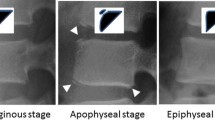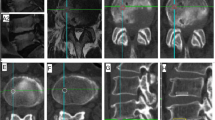Summary
Radiographic analysis was made on human lumbar vertebrae (1st to 3rd) from 101 autopsy cases (54 males, 47 females) without primary and secondary osteopathy. The materials consisted with 11 control cases (28–59 yr) and 90 cases of the aged subjects (60–92 yr). The aged subjects were divided into four groups by decades. One vertebral body was removed from the vertebral column and three bone specimens, one mid-sagittal (Plane A) and two mid-horizontal (Plane BL and BR) sections, of about 10 mm in thickness were prepared by a hand saw. Contact radiographs taken on films by a radiographic apparatus were analyzed.
Radiographic images of Plane A in control showed a typical checker pattern consisting of vertical and horizontal trabeculae within a rim of a transversely elongated square. Planes B showed a uniform ring pattern of about 1.0 to 1.3 mm in diameter within a semi-circular dense cortical margin. The trabecular image of the male was somewhat denser and wider than those of the female. Radiographically the aged vertebrae were classified into four types. Type I was a trabecular pattern indistinguishable from that of the control. Type IV was the most advanced from of vertebral atrophy. Type II and III were intermediate forms between previous two types. Early trabecular atrophy, which was characterized by slight decrease in trabecular density in Plane A and widened ring pattern in Planes B, was seen in Type II. In Type III, these features were further exaggerated. Horizontal trabeculae in Plane A became indiscernible and the ring pattern in Planes B widened more significantly. In Type IV, the typical trabecular pattern was no longer seen. Only a few trabeculae ran vertically crossing irregular horizontal trabeculae of thin appearance. These alterations appeared to be age-dependent as evident by an increasing percentage of Type III and IV in higher age groups: Group less than 60 yr (9 cases), Type I 72%, Type II 9%, unclassified 9%; Group 6 decades (12 cases), Type I 8%, Type II 84%, Type III 8%; Group 7 decades (40 cases), Type I 5%, Type II 25%, Type III 47.5%, Type IV 20%, unclassified 2.5%; Group 8 decades (37 cases), Type I 0%, Type II 19%, Type III 32.4%, Type IV 43.2%, unclassified 6.4%; Group 9 decades (1 case), one in Type III. Sex difference was not clearly appreciated. In addition, two types of trabecular alterations; (a) diffuse trabecular reinforcement, dominant in vertical direction, in vertebrae with advanced atrophy and (b) focal rare-faction in less atrophic vertebrae, were noted. Unusual trabeculae not seen in control specimens were recongnized in highly atrophic vertebrae. They may have been formed by remodelling of the cancellous bones against increasing weight stress on local tissues created by diminishing normal trabeculae.
Age-unrelated alterations were also noted. They were; (a) focal compact bone formation in both compact and cancellous bones, (b) exostosis and (c) fracture and flattening of the vertebral body. These changes may be seen more frequently in vertebrae with advanced atrophy; however, relation to ageing was inconsistent. The presence of a local fracture of both upper and lower rims without deformation of the vertebral body was distinguished. The significance of these radiographic alterations will be studied by a comparative histological examination on the same specimens used in radiography in future.
Similar content being viewed by others
References
Arnold, J. S.: Focal excessive endosteal resorption in aging and senile osteoporosis. In: Osteoporosis, edit. by Barzel, U. S., p. 80. New York-London: Grune & Stratton 1970
Arnold, J. S., Bartley, M. H., Tont, S. A., Jankins, D. P.: Skeletal changes in aging and disease. Clin. Orthop. 49, 17–38 (1966)
Atkinson, P. J.: Variation in trabecular structure of vertebrae with age. Calcif. Tiss. Res. 1, 24–32 (1967)
Atkinson, P. J., Woodhead, C.: The development of osteoporosis. Clin. Orthop. 90, 217–228 (1973)
Casuccio, C.: An introduction to the study of osteoporosis. Proc. roy. Soc. Med. 55, 663–668 (1962)
Delling, G.: Age-related bone changes. Curr. Top. Path. 58, 117–147 (1973)
Dominok, G. W.: Der alternsbedingte Wandel des feingeweblichen Bildes menschlicher Knochen. Ergebn. allg. Path. path. Anat. 49, 229–274 (1968)
Eder, M.: Der Strukturumbau der Wirbelspongiosa. Virchows Arch. path. Anat. 333, 509–522 (1960)
Author information
Authors and Affiliations
Additional information
The author is indebted to Dr. H. Shimada, Chief, Section of Autopsy Service, Yoikuin Hospital and Dr. S. Saiki, Chief, Section of Pathological Anatomy Service, St. Luke International Hospital, Tokyo in furnishing the materials used in this study. Skillful technical assistance of Mr. Y. Fujita, Photo Service, Tokyo Metropolitan Institute of Gerontology, in printing the x-ray negatives is acknowledged.
Rights and permissions
About this article
Cite this article
Tanaka, Y. A radiographic analysis on human lumbar vertebrae in the aged. Virchows Arch. A Path. Anat. and Histol. 366, 187–201 (1975). https://doi.org/10.1007/BF00427409
Received:
Issue Date:
DOI: https://doi.org/10.1007/BF00427409




